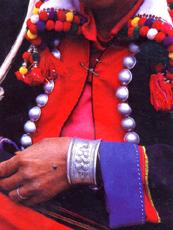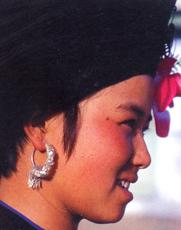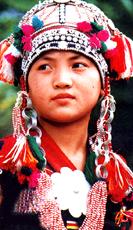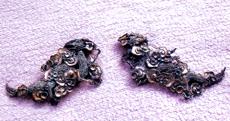| 
Among the rich and colorful costumes of Yunnan Province's ethnic minorities, silver adds the "finishing touch." People who have visited ethnic minority regions in Yunnan will be impressed by the various types of silver accessories worn by women and children: small, silver bells on bonnet, silver bracelets around women's wrists, numerous silver "bubbles" on their clothes, silver ear pendants, etc.

Yunnan: The Silver Province
Popular silver accessories among ordinary people include many famous pieces handed down from the Qing Dynasty (1644-1911) and the Republic of China (1912-1949); the earliest works can be traced back to the Song Dynasty (960-1279) and the Yuan Dynasty (1271-1368). There is a large collection of silver accessories at the Yunnan Provincial Nationalities Museum, Yunnan Provincial Art Gallery and the Museum of Yunnan Provincial Nationalities College, and there are some private collectors, too. Perhaps it is only in Yunnan Province that so many traditional silver accessories in various types can be found today.

The province has many different ethnic minorities who preserve their unique customs and costumes very well.
Silver production in Yunnan Province began long ago. According toThe Book of the Han Dynasty - Record of Geography, Zhuti Mountain, situated northeast of the Zhaotong area, produced much silver. The several major silver production areas in the Han Dynasty (25-220) -- Lugao (east of present-day Luliang County), Bengu (southeast of present-day Jianshui County) and Shuangbai - are all located in Yunnan Province. During the reign of Tianli (1328) of the Yuan Dynasty, tax on silver paid by Yunnan Province alone reached 36,780 taels, accounting for 47 percent of the country's total (77,560 taels). During the reign of Tianshun of the Ming Dynasty (1368-1644), the tax jumped to more than 100,000 taels, accounting for one-half of the country's total. During the reign of Kangxi of the Qing Dynasty, Yunnan had 19 silver processors and its tax on silver held a top position in China.
Knowledge about Silver Accessories

A large part of silver accessories are used by children, particularly silver locks. Since children are more vulnerable to disease and accidents, it is believed that wearing locks can "lock" life and drive away evil. Children of the Han people, Yi, Tibetan and Hani ethnic minorities also share in the custom of wearing silver locks and silver chaplets. Bonnets are also decorated with various silver accessories.

Little girls wear silver bracelets and silver earrings and more dainty headdresses when they grow up. Such silver accessories are mostly handed down from their mothers and grandmothers, like rings and bracelets sent by their lovers or fiancés as keepsakes. When they get married, they wear beautiful silver accessories all over their bodies to show that this is the best time of their lives. After the wedding, the girls become mothers and wear more decent, elegant silver accessories to indicate their status as housewives.

Craftsmanship of Making Yunnan Silver Accessories
There are three common ways to make Yunnan silver accessories: moulding and carving, joining single pieces and filigree inlaying.
These silver accessories incorporate white jade, jasper, topaz, emerald, turquoise, malachite, agate, amber, crystal, ivory or teeth of musk deer for inlaying. A silver accessory's beauty depends on both its pattern and the craftsmen's techniques.
|



